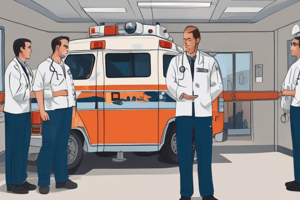Podcast
Questions and Answers
What is shock?
What is shock?
- A state of normal tissue perfusion, leading to cellular homeostasis and metabolic balance.
- A state of insufficient tissue oxygenation, leading to cellular necrosis and metabolic failure.
- A state of excessive tissue perfusion, leading to cellular hyperoxia and metabolic hyperfunction.
- A state of inadequate tissue perfusion, leading to cellular hypoxia and metabolic dysfunction. (correct)
Which of the following is a sign of shock?
Which of the following is a sign of shock?
- Flushing, warm skin
- Slowed, deep breathing
- Hypertension (high blood pressure)
- Rapid, weak pulse (correct)
What is the primary cause of hypovolemic shock?
What is the primary cause of hypovolemic shock?
- Severe bleeding (correct)
- Vasodilation
- Pulmonary embolism
- Heart attack
What is the characteristic of distributive shock?
What is the characteristic of distributive shock?
Which type of shock occurs when the heart is unable to pump blood effectively?
Which type of shock occurs when the heart is unable to pump blood effectively?
What is the primary goal of EMTs in managing shock?
What is the primary goal of EMTs in managing shock?
What is the primary goal of shock management by EMTs?
What is the primary goal of shock management by EMTs?
What is included in the circulation component of shock management?
What is included in the circulation component of shock management?
What is an example of a type of shock?
What is an example of a type of shock?
What is the purpose of the exposure component of shock management?
What is the purpose of the exposure component of shock management?
What is NOT included in the airway management component of shock management?
What is NOT included in the airway management component of shock management?
Why is it important for EMTs to be trained in shock management?
Why is it important for EMTs to be trained in shock management?
What is the primary consequence of inadequate blood circulation in the body?
What is the primary consequence of inadequate blood circulation in the body?
What is the purpose of the body's diversion of blood flow from the skin to vital organs during shock?
What is the purpose of the body's diversion of blood flow from the skin to vital organs during shock?
What is the effect of reduced blood volume on the pulse?
What is the effect of reduced blood volume on the pulse?
What is the primary reason for rapid, shallow breathing in shock patients?
What is the primary reason for rapid, shallow breathing in shock patients?
What is the effect of shock on brain function?
What is the effect of shock on brain function?
Why is prompt intervention crucial in shock patients?
Why is prompt intervention crucial in shock patients?
What is the primary benefit of elevating a patient's legs when they have injuries to their lower extremities?
What is the primary benefit of elevating a patient's legs when they have injuries to their lower extremities?
Which of the following interventions is NOT primarily focused on preventing blood loss?
Which of the following interventions is NOT primarily focused on preventing blood loss?
What is the primary purpose of using shock indicators and pulse oximeters?
What is the primary purpose of using shock indicators and pulse oximeters?
What is the primary benefit of calling for advanced medical help in a shock situation?
What is the primary benefit of calling for advanced medical help in a shock situation?
What is the primary goal of triage in relation to shock management?
What is the primary goal of triage in relation to shock management?
What is the primary focus of continued education for EMTs in relation to shock management?
What is the primary focus of continued education for EMTs in relation to shock management?
Flashcards are hidden until you start studying
Study Notes
Emergency Medical Technicians (EMTs) and Shock Management
Emergency Medical Technicians (EMTs) play a crucial role in pre-hospital emergency care, providing immediate medical assistance to patients in need. One of the critical aspects of their training includes the recognition and management of shock. Shock is a life-threatening condition that can be caused by various factors such as trauma, sepsis, or cardiac arrest. In this article, we will discuss the essential aspects of EMT training related to shock management, focusing on the identification of shock, its causes, and the necessary interventions.
Identification of Shock
Shock is a state of inadequate tissue perfusion, leading to cellular hypoxia and metabolic dysfunction. EMTs must be able to identify the signs and symptoms of shock, which can include:
- Pale, cold, clammy skin
- Rapid, weak pulse
- Decreased urine output
- Rapid, shallow breathing
- Confusion or disorientation
- Hypotension (low blood pressure)
Causes of Shock
There are several causes of shock, including:
- Hypovolemic shock: This is caused by a reduction in blood volume, often due to severe bleeding.
- Cardiogenic shock: This occurs when the heart is unable to pump blood effectively, typically due to a heart attack.
- Obstructive shock: This is caused by a blockage in the blood vessels, such as from a pulmonary embolism.
- Distributive shock: This is characterized by vasodilation, leading to a decrease in blood pressure. Examples include septic shock and anaphylactic shock.
Management of Shock
EMTs must be prepared to manage shock effectively. This includes:
- Airway management: Ensuring a clear airway and providing supplemental oxygen if necessary.
- Breathing: Assessing and supporting the patient's breathing, which may involve the use of a bag-valve mask.
- Circulation: Supporting the patient's circulation by maintaining a patent airway and performing chest compressions if necessary.
- Disability: Assessing the patient's neurological status and providing appropriate interventions if needed.
- Exposure: Ensuring the patient is adequately exposed for a rapid assessment and addressing any immediately life-threatening conditions.
Conclusion
EMTs play a vital role in the initial management of shock, which can be a life-threatening condition. Their training includes the identification of shock, its causes, and the necessary interventions. By following established protocols and guidelines, EMTs can provide critical support to patients in need, helping to save lives until they reach hospital care.
Studying That Suits You
Use AI to generate personalized quizzes and flashcards to suit your learning preferences.




